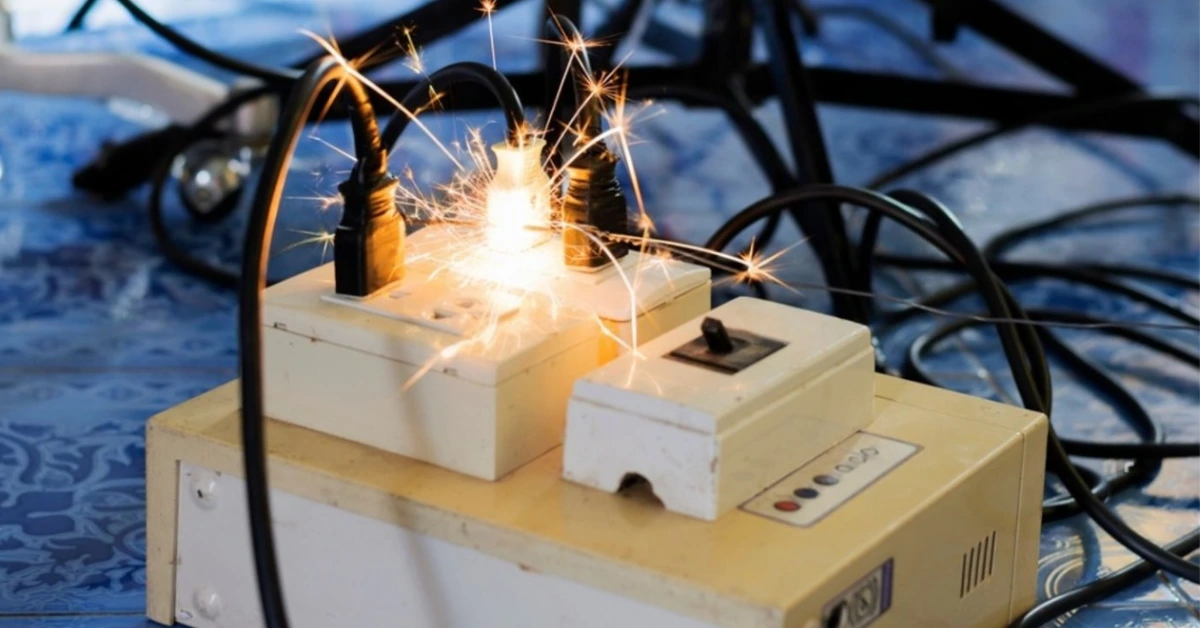A safe and fully functional electrical system is the unseen backbone of any home, powering everything from our lights to our most essential appliances. However, when issues arise, they can be more than just an inconvenience. Ignoring the warning signs of electrical problems can pose serious risks, including appliance damage, electrical shocks, and even fire hazards. Understanding these common issues and their solutions is crucial for maintaining a safe environment for your family.
Common Issues & Fixes of Electrical Problems
Many electrical problems in house settings have clear causes and solutions. This quick guide will help you identify potential issues, understand their origins, and get an idea of the associated repair costs.
| Service/Problem | Likely Cause | Suggested Solution | Estimated Repairing Cost (₹) |
|---|---|---|---|
| MCB/Fuse Replacement | A circuit overload or a short circuit caused the safety device to trip or blow. | Replace the blown fuse or faulty MCB unit to restore power to the circuit. | ₹99 – ₹250 |
| Switch or Socket Replacement | The internal mechanism is worn out, a wire has come loose, or the unit is cracked. | Replacement of the single faulty switch or socket unit to ensure a safe connection. | ₹60 – ₹150 |
| Frequent Breaker Trip | A circuit is consistently overloaded by high-power appliances. | An electrician inspects the load and may suggest redistributing appliances or upgrading the MCB. | ₹150 – ₹400 (for inspection/load balancing) |
| Faulty Wiring in an Outlet | A loose wire or a damaged connection behind the outlet plate. | Secure the wiring, or if the damage is significant, replace a small section of the wire. | ₹200 – ₹600 |
| Electrical Short Troubleshooting | A dangerous situation where a hot wire touches a neutral or ground wire. | A detailed inspection to locate the source of the short circuit and repair the damaged wiring. | ₹800 – ₹2,500+ |
| New Wiring Installation | Adding a new point for a light, fan, or outlet in a room. | Running a new wire from a power source, often concealed within a conduit pipe. | Starts from ₹65 per foot |
| General Electrician Booking | For diagnosing unknown power issues or multiple small problems. | An electrician visits to inspect the scope of work; this fee is often adjusted in the final bill. | Starts from ₹99 (Inspection Fee) |
Top 10 Common Electrical Problems in Homes
Here are ten of the most common issues homeowners face, along with their causes and recommended solutions.
Unbeatable Price 5-Star Rated Partner! 2200+ Shades! Top Quality Paint Free Cancellation!

Get a rental agreement with doorstep delivery

Find the BEST deals and get unbelievable DISCOUNTS directly from builders!

5-Star rated painters, premium paints and services at the BEST PRICES!
1. Flickering or Dimming Lights
Flickering lights are often a symptom of an unstable connection. This could be a simple issue, such as a loose light bulb, but if persistent, it points to a more serious wire problem, a loose connection in the main electrical panel, or an overloaded circuit struggling to provide consistent power.
2. Frequent Tripping of Circuit Breakers
A circuit breaker is a safety device designed to shut off power in case of overload or a fault. If a breaker trips often, it means a specific circuit is regularly overloaded. This is common when high-power appliances like microwaves, hair dryers, or air conditioners are used on the same circuit. The solution is to redistribute your appliances or have an electrician assess if an upgrade is needed.
3. Electrical Shocks When Using Appliances
Receiving even a mild shock from an appliance, switch, or outlet is serious. It typically indicates a grounding problem or faulty wiring within the appliance itself. A failure in this system can cause the appliance’s metal casing to become energised, posing a significant shock hazard that requires immediate professional attention.
4. Power Surges
Power surges are brief but intense spikes in your home’s electrical voltage. They can be caused by external factors like lightning strikes or grid switching by the power company, or by internal factors like a large appliance cycling on. These surges can degrade and destroy sensitive electronic components, making the use of high-quality surge protectors for computers, TVs, and other valuable electronics highly recommended.
5. Dead Outlets or Switches
The most common cause is a tripped circuit breaker or a GFCI outlet that has tripped and needs to be reset. If resetting the breaker doesn’t solve the power issues, it could indicate a more serious problem, like a loose connection or burnt wiring behind the outlet, which requires a professional inspection.
6. Burning Smell or Sparks
A burning smell or visible sparks from any outlet, switch, or appliance should be treated as an emergency. Turn off the power to the affected circuit at the main panel immediately. This is a critical sign of a dangerous fault, such as an electrical short, severely overloaded wiring that is melting its insulation, or a failing device. Do not attempt to fix this yourself; call a qualified electrician without delay.
7. High Electricity Bills
If your electricity bills suddenly spike without a corresponding increase in usage, it could be a symptom of underlying electrical issues. This might be due to faulty wiring causing ‘leaks’ of electricity, a malfunctioning appliance constantly drawing power, or an old electrical system that is no longer efficient. A professional energy audit can help pinpoint the source of this costly problem.
8. Buzzing Sounds from Switches or Sockets
Your electrical system should operate silently. A buzzing, humming, or crackling sound from a switch, outlet, or the breaker box is a clear sign of trouble. This noise is often created by electricity arcing (jumping) across a loose wire or a defective component. This arcing creates intense heat and is a major fire hazard that warrants an immediate call to an electrician.
9. Warm Outlets or Switch Plates
It is normal for some dimmer switches or charger plugs to feel slightly warm, but a standard outlet or switch plate should never feel hot to the touch. Heat is a sign of resistance, which often means there is a loose or failing connection behind the plate. This overheating can damage the outlet, melt the wire insulation, and create a significant fire risk.
10. Light Bulbs Burning Out Frequently
If you find yourself replacing light bulbs in a particular fixture far too often, the problem may not be the bulb itself. This issue can be caused by several factors: using a bulb with a higher wattage than the fixture is rated for, persistent vibrations, or poor wiring connections that deliver unstable voltage. It could also indicate overheating in the fixture due to poor insulation in the ceiling.
Diagnosing Electrical Issues – What to Check

Before calling for help, performing some basic electrical troubleshooting can help you narrow down the problem.
- Check the Main Breaker: First, look at your circuit breaker panel to see if any of the switches have tripped to the ‘off’ or middle position.
- Test Other Outlets: If one outlet is dead, check other outlets in the same room to see if the problem is isolated or affects the entire circuit.
- Isolate the Appliance: If a breaker trips when you turn something on, unplug that appliance and reset the breaker. If it holds, the appliance is likely the problem.
- Look for GFCI Outlets: Check for GFCI outlets (common in kitchens and bathrooms) and press the ‘reset’ button if it has popped out.
- Check Light Bulbs: If a light fixture isn’t working, the simplest explanation is a burnt-out bulb. Try replacing it before assuming a wiring issue.
- Note Any Patterns: Pay attention to when problems occur. Does it only happen when it rains, or when you use a specific device?
- Use Your Senses: Note any unusual smells (like burning plastic) or sounds (like buzzing or humming) and where they are coming from.
DIY vs Professional Help: What’s Safe to Fix Yourself?
When it comes to electrical problems and solutions, safety is paramount. Simple tasks like changing a lightbulb or resetting a tripped circuit breaker are generally safe for homeowners. However, any task that involves opening an outlet, handling wires, or working inside the main electrical panel carries a significant risk of shock or creating a fire hazard if done incorrectly. For these issues, it is always best to trust the expertise of a qualified professional, like the verified electricians available through NoBroker, to ensure the job is done safely and correctly.
Preventive Maintenance Tips
The best way to deal with electrical issues is to prevent them from happening in the first place. These simple maintenance habits can greatly improve the safety and reliability of your home’s electrical system.
- Schedule Regular Professional Inspections: Have your electrical system inspected by a qualified electrician every 5-7 years, especially in an older home.
- Don’t Overload Outlets: Avoid using too many multi-outlet adapters or extension cords on a single outlet, as this can cause overheating.
- Check Cords and Plugs: Regularly inspect appliance cords for signs of fraying, cracking, or damage, and replace them if necessary.
- Install GFCI and AFCI Protection: Ensure Ground Fault Circuit Interrupters (GFCIs) are installed in wet areas, and consider Arc Fault Circuit Interrupters (AFCIs) for enhanced fire prevention.
- Use Bulbs with the Correct Wattage: Always check the maximum wattage rating on a light fixture and use bulbs that comply with it to prevent overheating.
- Keep Flammable Materials Away: Do not place flammable items like curtains or paper over electrical cords or outlets.
- Unplug Small Appliances When Not in Use: This not only saves energy but also protects the devices from unexpected power surges.
- Know Your Breaker Panel: Take a moment to learn where your main electrical panel is located and how to turn off the power to specific circuits or the entire house.
Let NoBroker Help with Electrician Services
Dealing with electrical power quality and safety should not be a guessing game. It is crucial to act fast on small warning signs to prevent them from becoming major hazards. When you are faced with a problem beyond a simple reset, you should always prefer expert help. NoBroker makes it easy to book affordable and verified electrician services for safe, reliable solutions. Our professionals can handle everything from simple repairs to complex troubleshooting, ensuring your home’s electrical system is in safe hands.
Frequently Asked Questions
Ans: Homeowners often notice electrical issues and might consider fixing them themselves. However, it’s crucial to understand the risks. Electricians have a valid licence, attained after rigorous training and although seemingly just paper, it is vital for preventing accidents and ensuring well-being.
Ans: High electricity-consuming home appliances include ACs, heaters, water heaters, dryers, fridges, and ovens. Actual usage however varies based on your appliance’s efficiency, frequency of use, and home size.
Ans: An outdated electrical panel may not meet your home’s current demands, especially with the increasing number of electronics and appliances. Older panels, around 25 years old or experiencing frequent shorts and dimming lights, signal the need for an upgrade.
Ans: You must choose the ideal wiring by considering factors like electrical load, safety regulations, budget, installation environment, longevity, and consulting a professional electrician. Top brands for home wiring include Plaza Cables, RR Cable, Polycab Wires, Syska Wires, Finolex, Leo Cable, Havells India, Universal Cable, V-Guard Industries Ltd, and Uniflex Cables Ltd.
Ans: Common signs include flickering lights, frequently tripped breakers, a burning smell, warm or discoloured outlets, and receiving mild shocks from switches or appliances.
Ans: Flickering can be caused by a loose bulb, an overloaded circuit, or a faulty connection somewhere in the wiring or main panel.
Ans: A burning smell is a serious danger sign, typically caused by overloaded wiring overheating and melting its plastic insulation, or a loose, arcing connection.
Ans: Yes, it is generally safe to reset a tripped breaker once. If it trips again immediately, leave it off and call an electrician as there is a persistent fault.
Ans: For most homes, a professional electrical inspection is recommended every 5 to 7 years, or sooner if you live in an older house or notice any warning signs.
Loved what you read? Share it with others!
 krishnanunni,Author
krishnanunni,Author
Krishnan grew up in the libraries of Thiruvananthapuram. As an engineer turned writer, Krishnan is fascinated by the stories told by cities through their buildings, culture and music. His blogs are aimed at breaking down the most relevant and actionable insights on the Indian realty sector.
Source link




